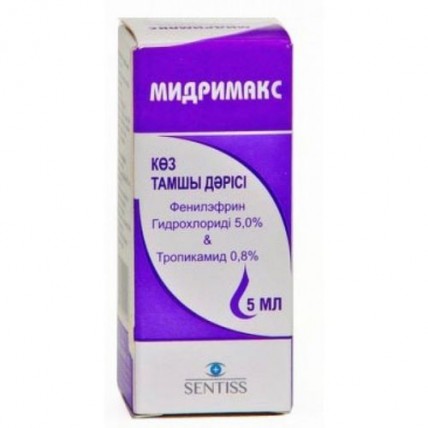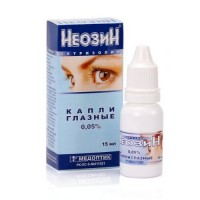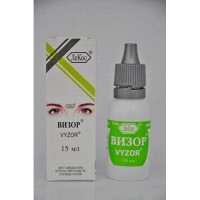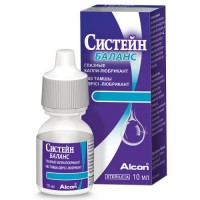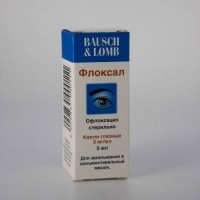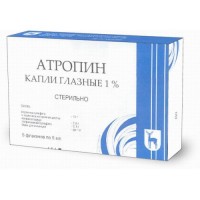The instruction for medical use of Midrimaks Torgovoye medicine a name of Midrimaks the International unlicensed name Is not present the Dosage form of the Drop eye the Structure of 1 ml of drug contains active agents: Phenylephrinum hydrochloride of 50 mg, tropikamid 8 mg, excipients: sodium metabisulphite, a benzalkoniya chloride, dinatrium edetat, a gipromelloza, sodium hydroxide, acid chlorohydrogen, water for injections. The description Transparent solution from colourless till light brownish-yellow color. Pharmacotherapeutic group Drugs for treatment of diseases of eyes. Midriatiki. Tropikamid in a combination with other drugs. The ATX S01FA56 code the Pharmacological Pharmacokinetics Fenilefrin properties easily gets into eye tissues, the peak of concentration in plasma arises in 10-20 minutes after topical administration. Phenylephrinum is removed by kidneys in not changed look (& lt, 20%) or in the form of inactive metabolites. Tropikamid easily gets into tissues of an eye and is quickly soaked up in a blood stream. When using of the modified radio receptor analysis the lower limit of definition of a tropikamid in plasma made less than 240 pg/ml, range — 240 pg/ml – 10 ng/ml. Average maximum concentration in plasma in the fifth minute after introduction made 2.8 ± 1.7 ng/ml. In the 60th minute the concentration of a tropikamid in plasma made 0.46 0.51 ng/ml, and on the 120th — it is lower than 240 pg/ml. The pharmacodynamics Fenilefrin – a sympathomimetic, has the significant alpha and adrenergic activity. At topical administration in ophthalmology causes mydriasis, improves outflow of intraocular liquid and narrows conjunctiva vessels. Phenylephrinum possesses the significant promoting effect on postsynaptic alpha adrenoceptors, makes very weak impact on beta1-adrenoceptors. Possesses the vasopressor action similar to effect of Norepinephrinum (noradrenaline), at the same time it practically has no chronotropic and inotropic impact on heart. The angiotonic effect of Phenylephrinum is weaker, than at noradrenaline, but is longer. After instillation Phenylephrinum reduces the dilator of a pupil and unstriated muscles of arterioles of a conjunctiva, thereby, causing mydriasis. The mydriasis comes within 10–60 min. after single burying and remains during 4–6 h. The mydriasis caused by Phenylephrinum is not followed by a tsikloplegiya. Phenylephrinum influences accommodation process, stimulating accommodation afar. At the same time the further point of clear vision is removed, and the provision of the next does not change. Phenylephrinum supplements action of a tropikamid as mechanisms of their action differ. Introduction together with tropikamidy Phenylephrinum reduces or stops ability of a tropikamid to increase intraocular pressure. Tropikamid - M-holinoblokator, blocks m-holinoretseptory of a sphincter of a pupil and a tsiliarny muscle, causing a short-term mydriasis and paralysis of accommodation. Slightly increases intraocular pressure. The mydriasis against the background of use of a tropikamid develops in 5-10 minutes and reaches a maximum by 20-45 minute. The maximum mydriasis remains within 1 hour and is normalized in 6 hours. Indications It is used as mydriatic means: - at diagnostic ophthalmologic procedures - before surgical and laser operations - for spasmolysis of accommodation and therapy of the progressing short-sightedness (as a part of complex therapy) the Route of administration and doses For mydriasis at diagnostic ophthalmologic and surgeries in a conjunctival cavity dig in on 1-2 drop in 15-30 minutes prior to the procedure or operation. For correction of disturbances of accommodation – every other day to dig in on 1 drop in each eye for the night within 2-4 weeks Side effects Local: - allergic reactions - increase in intraocular pressure - passing pain, burning in an eye and a photophobia - passing decrease in sight - release of a pigment in watery moisture with temporary increase in intraocular pressure - blocking of a corner of an anterior chamber (when narrowing a corner) - pain in the field of superciliary arches - dacryagogue, conjunctiva hyperaemia, a keratitis Seldom – a reactive miosis next day after use (repeated instillations of drug can give less expressed mydriasis at this time, than the day before, this effect is more often shown at elderly patients). System: - pallor, dryness in a mouth, reddening and xeroderma - contact dermatitis - a headache - bradycardia - tachycardia and arrhythmia - increase in arterial blood pressure - ventricular occlusion of coronary arteries - an embolism of a pulmonary artery - disturbance from central nervous system and muscular rigidity - frequent desires on urination - urination difficulty, decrease in a tone of digestive tract and a vermicular movement, leading to a constipation is rare - vomiting and dizziness - elderly patients with diseases of a cardiovascular system have ventricular arrhythmias, the Contraindication myocardial infarction - hypersensitivity to any of drug components - narrow and closed-angle angle glaucoma - diseases of a cardiovascular system (including a coronarosclerosis, stenocardia, arrhythmia, hypertensive crisis) - a thyrotoxicosis - a concomitant use (and also 3 weeks after their cancellation) inhibitors of a monoaminooxidase (MAO) - children's age up to 12 years - pregnancy and the period of feeding by a breast Medicinal interactions When assigning blockers of beta adrenoceptors strengthening of vasoconstrictive effect of Phenylephrinum due to suppression of vasodilation by them is possible. Because of risk of developing of acute hypertensia sharing of Phenylephrinum and a guanetidin and also any other blocker of adrenergic neurons or inhibitor of the return neuronalny capture is not recommended. Use in combination with monoamine oxidase inhibitors and within three weeks after the termination of their reception increases risk of development of system adrenergic effects. Angiotonic effect of adrenergic medicines can also amplify at combined use with tricyclic antidepressants, propranolol, guanetidiny, metildopy and m-holinoblokatorami. Preliminary instillation of local anesthetics can increase system absorption and prolong a mydriasis. Special instructions Owing to considerable reduction of the dilator of a pupil in 30-45 min. after instillation in moisture of an anterior chamber of an eye can be found pigment particles from a pigmentary leaf of an iris of the eye. The suspension in chamber moisture needs to be differentiated with manifestations of a front uveitis or with hit of uniform elements of blood in moisture of an anterior chamber. The preservatives which are contained in drug can be adsorbed by soft contact lenses. Drug can render irritant action approximately when carrying contact lenses therefore any contact lenses should be removed before burying and to put on not earlier than in 15 min. after it. Drops should be dug in in the lower conjunctival sac. For reduction of risk of development of systemic side effect the easy pressing by a finger on area of a projection of dacryocysts at an internal corner of an eye within 1-2 min. after burying is recommended. The patients using contact lenses before use of drug should remove lenses and to establish them back not earlier than in 15 minutes after burying drug. With care Diabetes 2 types, advanced age (risk of developing ventricular arrhythmias and a myocardial infarction at patients with diseases of a cardiovascular system). Features of influence of medicine on ability to run the vehicle or potentially dangerous mechanisms. After use of drug owing to change of accommodation and size of a pupil, decrease in visual acuity is possible therefore use of drug is not recommended when driving vehicles and at occupation by other potentially dangerous types of activity demanding the increased concentration of attention and speed of psychomotor reactions. Overdose Symptoms: in case of excess administration of drug inside - dryness of skin and mucous membranes, a hyperthermia, tachycardia, a mydriasis, excitement, spasms, a coma, breath paralysis. Treatment: gastric lavage, intake of activated carbon, as antidote – physostigmine salicylate (0.03 mg/kg intravenously slowly), benzodiazepines, for elimination of a hyperthermia – cold compresses. For stopping of systemic action of Phenylephrinum – α-adrenoblockers (5-10 mg of phentolamine intravenously, if necessary repeat an injection). Form of release and packing of the Drop eye. On 5 ml of drug in plastic bottles droppers. On 1 bottle dropper together with the screw-on cap in which there is a device for opening of a bottle and with the instruction for medical use in the state and Russian languages place in a cardboard pack. To Store storage conditions in the place protected from light at a temperature not over 25C. Not to freeze. To store out of children's reach! A period of storage 2 years the use Period after opening of a bottle 1 month. Not to use after the expiry date specified on packing! Prescription status According to the prescription of Proizvoditel SENTISS FARM Pvt. Ltd. 212/D-1, Greene Park, New Delhi, India At the plant: Villidzh Khera Nikhla, Tekhsil Nalagarkh, Region of Solan, Himachal Pradesh 174,101, India Name and country of the owner of the registration certificate of SENTISS FARMA of Pvt. Ltd., India
to Develop
to Develop
